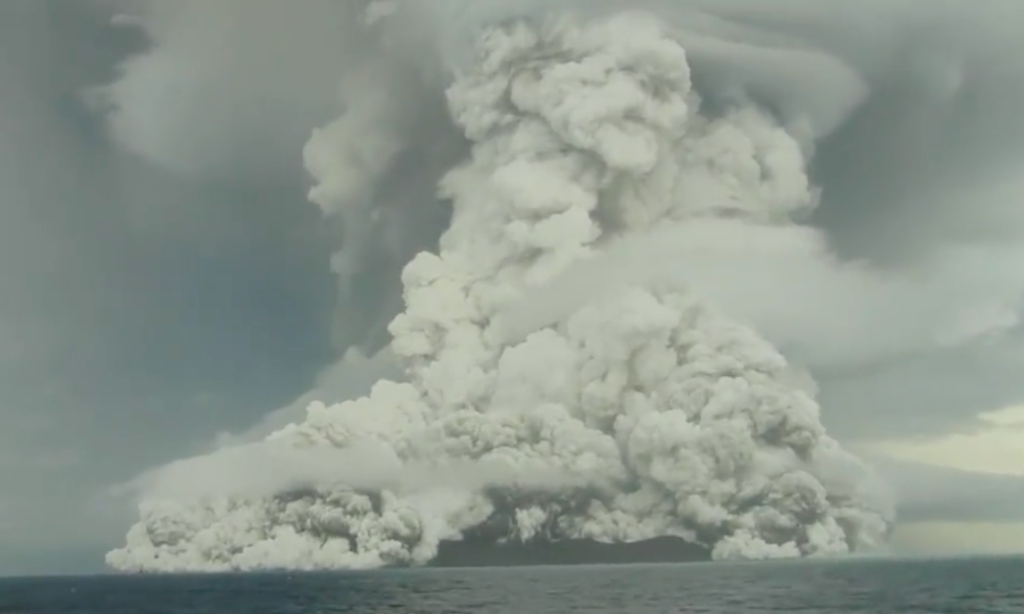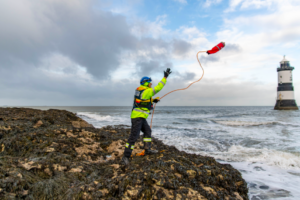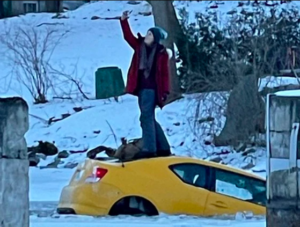WATCH: Aftermath of powerful tsunami as 50+ boats damaged and dozens sunk

Boat owners and businesses at Tutukaka Marina, New Zealand, are still shaken up from Saturday night’s tsunami surges following the large volcanic eruption in Tonga and large swells from Cyclone Cody that damaged at least 50-60 boats and sunk around a dozen other boats.
Surging seas damaged boats in the popular North Island coastal settlement, according to the New Zealand Herald.
“My boat and many others have been completely destroyed by a tsunami that has hit Tutukaka Marina in Whangarei,” one local told the paper.
“Multiple boats have been destroyed. The wave cleared the breakwater which is around 2m higher than the high tide line. There was absolutely no Civil Defence warning, no tsunami siren activated and no phone notifications. We read a notice on the news earlier and took little notice. We have had multiple tsunami alerts [previously] which has triggered the alarm system and boats have been completely fine.”
New Zealand’s prime minister Jacinda Ardern says Tonga’s capital Nuku’alofa suffered ‘significant’ damage from a powerful volcanic eruption that triggered a tsunami over the weekend.
The tsunami followed the eruption of Hunga Tonga-Hunga Haʻapai, an underwater volcano, sending ash, steam and gas up to 20km into the air. A 1.2m wave swept ashore in the capital.
US Stormwatch says the eruption is one of the most violent ever captured on satellite.
Tonga’s Hunga Tonga volcano just had one of the most violent volcano eruptions ever captured on satellite. pic.twitter.com/M2D2j52gNn
— US StormWatch (@US_Stormwatch) January 15, 2022
Tongan eruption from boat.#Tonga #Tsunami pic.twitter.com/Ls64vq1YU4
— Lynn Schore (@LynnSchore) January 15, 2022
According to Tonga Geological Services, the plumes of gas, smoke and ash reached 20km into the sky. It is the latest in a series of eruptions of the volcano, which is 65km north of the capital Nuku’alofa.
The eruption – captured in satellite images that show a huge plume of ash, steam and gas rising from the ocean – was heard and felt as far away as in Fiji (500 km away) and Vanuatu, where people reported feeling the ground and buildings shaking for hours, says The Guardian.
The explosions were even heard in New Zealand, more than 2300km away, and the affects were felt by fishermen on the coast of South America.
Fishermen came face to face with the #tsunami caused by the #eruption of the #Tonga #underwater #volcano.
— Journalist Siraj Noorani (@sirajnoorani) January 16, 2022
A slight swell phenomenon was observed on the entire west coast of South America
Please #evacuate to higher ground ASAP”. #Oceania #warning #violent #tongatsunami #Peru pic.twitter.com/wgAfKFBDNZ
Ardern’s comments on Sunday came as Pacific nations and humanitarian groups struggled to establish communications with Tonga, a day after the disaster.
Ardern added that New Zealand was not able to send a military surveillance flight over Tonga because the ash cloud was 19,000 metres (63,000 feet) high but they hoped to send the flight on Monday (17Jan22), followed by supply planes and navy ships. New Zealand’s Defence Force said in a tweet that it was ready to send a reconnaissance aircraft ‘as soon as atmospheric conditions allow’.
Tsunami videos out of Tonga 🇹🇴 this afternoon following the Volcano Eruption. pic.twitter.com/JTIcEdbpGe
— Jese Tuisinu (@JTuisinu) January 15, 2022
Damage in Tutukaka Marina
Civil Defence Northland is warning people not to go sightseeing after the damage at Tutukaka.
The area is still seeing “frequent and strong surge activity” from both the eruption and Cyclone Cody and it’s likely to be happening along Northland’s entire east coast, Civil Defence Northland told the NZ Herald.
“Experience from past tsunami events has been that this activity can continue for a number of days, and that locations that have previously been calm can suddenly experience unpredictable surges.”
Some SERIOUS damage done to a number of boats at the TUTUKAKA marina in the early hours this morning. The tsunami from the Tongan volcano was bigger and faster than many bargained on. Mother nature angry as just now. pic.twitter.com/8zw5IdqMgw
— 🇳🇿☯️ Infideliter 🚜🐏🐂🌽🇳🇿 (@CraigS2021) January 15, 2022
Dive Tutukaka co-owner Jeroen Jongejans says the business has already lost millions in turnover since 2020 because of Covid-19, and this will just add more to it.
Jongejans says they pulled the boats as much as they could on Saturday night. The first thing they did the next morning was move all the debris, the broken pole and the broken marina parts, and moved the sunken boats that they could move out of the way to prevent further damage.
There were no Tsunami warnings issued by Civil Defence (CDem) but National Emergency Management Agency advised the coastal communities in NZ to expect strong, unusual currents and unpredictable surges at the shore.
Jongejans says it would have been “nice” if they had been notified with a tsunami warning because they had done a lot of training and exercises around it.
“But if you don’t know it is coming, and you only know when it is here then it is a bit too late to do anything or put those training to use.”
“Part of the marina, not ours, has been totally damaged and will take a long time and millions of dollars to get it all fixed.
“We just got to be positive, proactive, focused and not dither around, we cannot afford to be dithering.
“If we cannot operate, it has a significant impact on the economy of Tutukaka, cafes and everything. If people can’t go out and visit, they don’t stay and avoid the place, and Tutukaka Marina has generated a lot of income for our community. When it is partly closed off, it will have an impact afterwards.
“Hopefully, not too bad, but we will have to wait and see.”
Boater saved by handbag
Peter Jack Ansell and Dom Gardiner had just gone to bed on their boat at the marina when they heard a loud bang.
“There was no warning, we just heard a massive explosion and everything started happening. There were big surges coming in the whole night after that.”
Gardiner says they were at the end of a marina finger when the whole thing broke off, swinging them to the other end with two other boats.
“There was a red catamaran which broke, took out the end of D street, sunk a boat on the end of this way and then broke us off.
“The fingers of marina just unbuckled and then broke, while we were still tied to the broken end and that swung us around and laid against the poles on the outside. I managed to lash it on and got off.”
The hit damaged the front of their boat and broke windows. Gardiner hit something on the boat, and when she finally managed to get off, she tipped into the water but luckily landed on to another boat.
“The water was just pulling me towards the marina, which was okay, and then I just used my handbag because it was full of water and heavy, so I managed to pull my handbag onto one of the boats and the weight just held me on to the boat until the marina manager came and rescued us.”
Gardiner did not suffer any physical injuries but felt sore and a bit “shaken”.
Reverberations across the Pacific
The eruptions triggered tsunami warnings across the Pacific, including in Samoa, Australia, Japan, Hawaii, Chile and the US Pacific Coast.
Australia’s Bureau of Meteorology says a tsunami wave height of 1.27m was observed on Norfolk Island and an 82cm wave was registered on the Gold Coast.
#goldcoast Australia. Tsunami waves this morning. Boat capsized, fisherman in water.. eventually made it back to shore. #Tonga
— Noella Nix 🐨 (@Noellanix) January 16, 2022
Credit: Rachel Roy pic.twitter.com/cimA117BkY
Japanese broadcaster NHK reported waves of more than a metre hitting coastal areas and said authorities advised about 230,000 people to evacuate.
A 1.2m wave reached the remote southern island of Amami Oshima and other areas along Japan’s Pacific coast observed smaller surges, says the Japan Meteorological Agency.
Watch video of the first wave arriving in Japan.
16日午前0時半前、津波注意報が出されている高知県土佐清水市の港の映像からは、海面が上下するのにあわせて係留されている船がゆっくりと上下したり左右に揺れたりしている様子が確認できます。https://t.co/5plmIcphz6#nhk_video pic.twitter.com/2spq3znm6c
— NHKニュース (@nhk_news) January 15, 2022
In Chile, waves of 1.74m were measured in the coastal town of Chanaral, while smaller waves were seen along the Pacific coast from Alaska to Mexico according to Aljazeera.
WATCH: Boats were overturned and damaged in Japan, New Zealand and Peru after Tonga’s underwater volcano eruption triggered a tsunami https://t.co/GpWI5liHQB pic.twitter.com/cq4CkIS1hu
— Bloomberg Quicktake (@Quicktake) January 16, 2022
In Hawaii, the Pacific Tsunami Warning Center reported waves slamming ashore from half a metre in Nawiliwili, Kauai, to 80cm in Hanalei.
Beaches and piers were closed across southern California as a precaution, but the National Weather Service tweeted that there were ‘no significant concerns about inundation’.
In Samoa, more than 100 families were reportedly evacuated from villages on the southern side of the big island of Savaii after wave surges hit homes at Vailoa, Palauli.
Locals told Samoa’s Eyespy Radio that “huge waves” struck the coastline and caused damage to houses in the villages of Palauli and Satupaitea.
Villagers reported windows “rattling” shortly beforehand and what were initially thought to be thunderstorms were remnants from the volcano eruption in Tonga.
WATCH: Police boat capsizes due to tsunami waves generated by Tonga volcano eruption near Los Angeles, CA pic.twitter.com/DQJU4FSh2z
— Cicada News (@cicada_news) January 16, 2022
The scene at the Santa Cruz Harbor as a tsunami generated tidal surge causing damage Saturday morning #TsunamiAdvisory pic.twitter.com/9ijKU9ZVaK
— Vern Fisher (@VFisher45) January 15, 2022
From a friend at Santa Cruz Harbor @NWSBayArea @Weather_West pic.twitter.com/ZUgfXcbSxw
— Dylan (@hamilton4391) January 15, 2022











